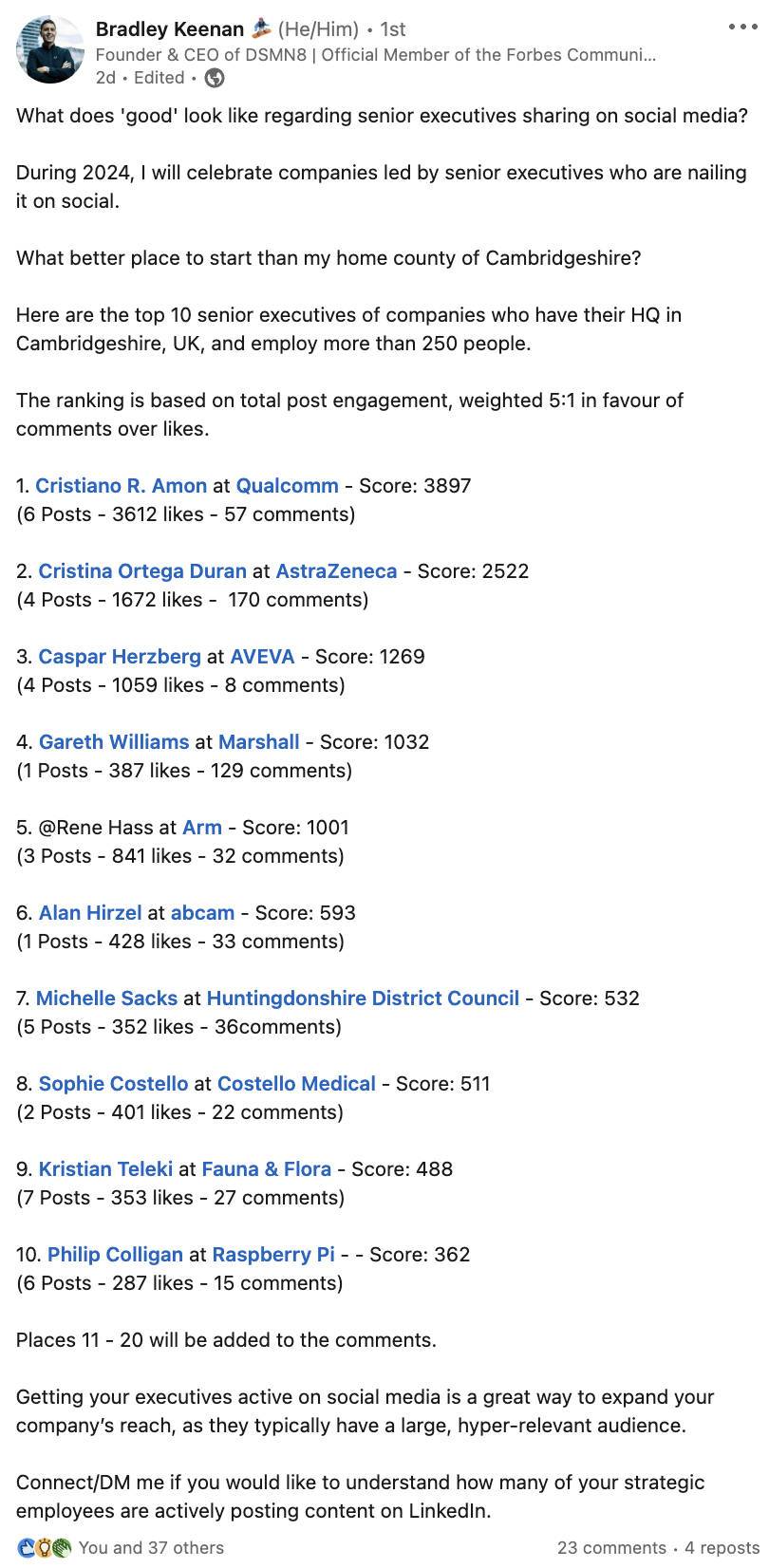
Executive social media.
Why is it important?
Does your CEO really need to be active on LinkedIn?
Will their social media activity have a real impact on your business?
In short, yes.
In this article, we’ll be covering why executives should share content, the impact their social media presence has, and why you need an executive social media strategy in 2024.
We’ll also cover the three essentials for executive content, and how to streamline the process to make it as easy as possible.
Why Executive Social Media Should Be Part of Your 2024 Strategy
The demand for transparency is higher than ever.
According to the Edelman Trust Barometer 2023, 63% of consumers and employees buy or advocate for brands based on beliefs and values.
Furthermore, having societal impact is a ‘strong expectation or deal breaker’ when considering a job for 69% of respondents from 28 countries.
With trust in governments and media at a low point, people are looking towards businesses to reflect their values and speak on societal issues that matter.
Customers, clients, and prospective employees now expect your CEO to have an active presence on social media. It’s no longer a nice-to-have, it’s an essential.
And to put it simply, people trust people.
We want to see authentic content on social media by people, not just marketing content from brand accounts.
If your senior leadership team share their insights on industry news and behind-the-scenes content demonstrating what it’s like to work for your organization…
You’ll be miles ahead of any competitors who rely on brand channels only.
In fact, 82% of consumers are more likely to trust a company whose CEO is active on social media.
And 79% of professionals would prefer to work for them!
Top 10 Senior Executives on LinkedIn in Cambridgeshire, UK [December 2023]
To emphasize the significance of executive social media activity, our very own CEO, Bradley Keenan, has started a series on LinkedIn to champion other leaders doing this well.
Throughout 2024, he will share the data revealing which executives are creating and sharing content, giving them a score based on post frequency and engagement.
To start, Bradley showcased the top executives creating LinkedIn content, based in his home county of Cambridgeshire, UK.
Check out Bradley’s post on LinkedIn for the full list, including those ranked in positions 11-20. Follow Bradley to keep up with future executive influence leaderboards!
What Is the Impact of This Activity?
These executives are generating impressions and engagement on social media, which supports their organization’s marketing activity.
But that’s not the only benefit.
It’s a common misconception that employee advocacy solely benefits marketing teams, when in reality, it impacts all areas of your business.
For starters, if your CEO, COO, or any other member of your executive leadership team shares content, they’re humanizing your brand.
This demonstrates transparency, making your organization more desirable for prospective employees.
Attracting top talent starts at the top. According to Glassdoor, approximately 79% of potential recruits will look at your company’s social media presence before applying for a role.
What will they see when they search for your organization?
Just marketing content?
Or authentic posts from your leadership team and employees, showcasing your company culture?
Bradley and Lewis cover this very topic in an episode of the Employee Advocacy and Influence Podcast.
Executive social media presence also has a significant impact on sales.
Remember the Edelman Trust Barometer we mentioned earlier?
Consumers expect CEOs to have a voice, and that voice represents the company as a whole.
Think of your C-Suite, especially your CEO, as a living embodiment of your company culture. Their social media posts demonstrate the values your organization wants to showcase to the world.
So far, we’ve been focusing on the external impact. But the social media presence of your senior leadership team has a big internal impact too.
First of all, if your CEO is regularly sharing LinkedIn content about your company and industry, employees will be up-to-date with the latest news.
This also helps employees feel connected with leadership, resulting in higher levels of engagement and talent retention.
Access to the C-Suite is very limited to most employees at work. So why not have your executives connect with your team on LinkedIn? A simple like or comment on their content goes a long way!
3 Executive Social Media Strategy Essentials
Now we’ve covered why it’s time to get your executives active on social media, let’s delve into the how.
When pitching this concept to leadership, the best way to get buy-in is to approach them with a proposed strategy from the get-go.
These are the 3 essentials you must include in your executive social media strategy:
1. Address potential blockers. These tend to be lack of time, or a lack of understanding about the benefits of maintaining an active social media presence as a business leader.
2. The logistics. Who will be involved in content creation and approval? How much work is required from participating executives?
3. How will you monitor the results? Share the KPIs you’ll be tracking, e.g. content impressions and engagement, website traffic from social media, and earned media value. If you’re using an employee advocacy platform like DSMN8, these metrics will be tracked for you.
How To Streamline Executive Social Media Management
If you take one thing from this article, let it be this:
Make it easy for executives to share content.
Even if they understand the value of maintaining an active LinkedIn presence, many executives will simply lack the time, and it will get pushed to the wayside amongst their more time-pressing tasks.
Technology like DSMN8 makes the process as smooth as possible.
Designated content admins can create content with multiple image and caption options, ready for your executives to share with their social media networks.
This requires minimal time commitment from your busy leadership team!
To make things even easier, the DSMN8 platform also features automation functionality, meaning that your executives can have a completely hands-off approach if they desire.
But whether you’re using employee advocacy software or not, there are ways to streamline your executive social media content process.
Some of your leadership team might already be pros at writing LinkedIn content, but others may not be confident writers, or lack time in their schedule to prioritize it.
Start by choosing your admins. These people (or person) will create and curate content for your leadership team to share.
If your organization is already running an employee advocacy program, this will be an easy decision! If not, think about who in your marketing team will be the best fit for creating executive content.
Next, establish content pillars. These will be the main content types and topics for your executives. The three pillars we recommend are:
- Company Content.
- Company Culture Content.
- Industry News / Third-Party Content.
For executives, there tends to be more of a focus on company news like acquisitions, mergers, or financial reports. After all, they are the leaders of your organization!
But it’s important to not neglect the other two content pillars. Company culture content is key for showcasing the human side of your brand to attract talent.
Industry news, on the other hand, provides an opportunity for leaders to add their own insights and establish themselves as thought leaders. This adds authenticity to their content: rather than solely being written by your content admin, your executive can share their opinions too.
Final Thoughts & Additional Resources
Getting your executives active on social media is crucial for organizations in 2024.
From building trust with customers and clients, to recruiting and retaining top talent, the impact is clear.
To get leadership on-board, approach them with a clear strategy, highlighting the benefits of this activity, and offer content creation support and social media training from your marketing team.
The key is to make it easy for executives, and reduce the time required from them to get involved.
For further support in getting your executives active on social media, use these resources:
Ready to start an employee advocacy program that your employees will actually want to participate in?
Choose a time to speak with the team.
Prefer to jump straight in and explore the platform?
Book a Demo of DSMN8, the #1 employee advocacy platform.
Emily Neal
SEO and Content Specialist at DSMN8. Emily has 10 years experience blogging, and is a pro at Pinterest Marketing, reaching 1 million monthly views. She’s all about empowering employees to grow their personal brands and become influencers.





